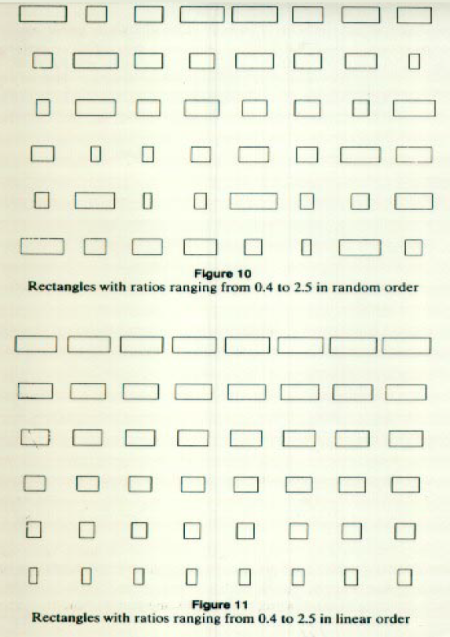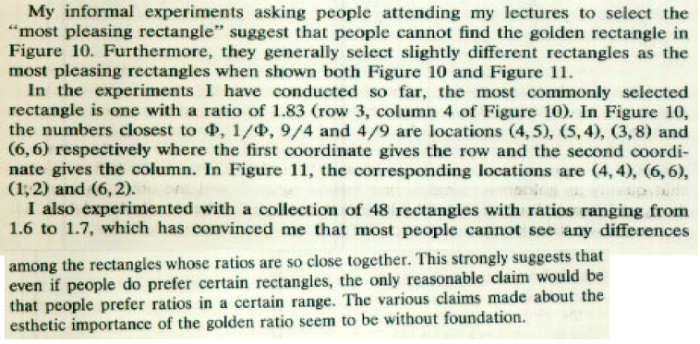the esthetic satisfaction of a golden rectangle
"A rectangle with - ratio is the most satisfying."
Disclaimer:
This claim doesn't fit and was frequently rejected in tests.
Important in the story of the GR is the German psychologist Fustav Theodor Fechner (1801-1887).
He introduces the concept Aesthetics from below. He's critical about an ideal concept in advance and was the first one to do empiric search about aesthetic preferences. As a child of his time Fechner isn't value-free. The choice of his research groep is significant: "Of course you can't exprect children and uncivilised n. to have the same preferences as the grown up civilised European". (Vorschule der Aesthetic 1804).
Fechner presents 10 rectangles with the same area of 64 cm² in random order on a table and lets the people taking part in the test chose the most attractive one.
(1:1, 6:5, 5:4, 4:3, 29:20, 3:2, 34:21, 32:13, 2:1 en 5:2)
The results clearly show a preference for the ratio 34:21 = 1.619).
What a score of a test group exactly means is another thing. Fechner doesn't see any harm in using the avarage score of a testing group as criterion for the taste of the individual.
Fechner is frequently critisied on the preconditions and methods of his tests. His tests were overdone by others, with diverse results. So his role in the story of the GR is ambiguous:
- It's groundbreaking that no longer aesthetics are topdown defined out of philosophical or religious ideas.
- His heritage is his conclusion that indeed GR has got an aesthetic preference. By this his tests become an argument for who sticks to the GR as an absolute aesthetic standard. This doesn't honour Fechner. Unlike to his conclusion that one interprets the GR positively, Fechner doesn't estimates the use of his searchings as very high. In catalogues he examines the ratio's of more than 10 000 paintings in European musea. In his Vorschule der Aestetik II he writes that, in contrast with his earlier search on rectangles out of context, it's clear that the GR hasn't got any preference for the width-height ratio.
dissent
Interesting is the article 'Misconceptions about the Golden Ratio' by George Markowsky.
In his artikel Markowsky shows two sets of rectangles with ratio 0.4 till 2.5
In the first set (fig. 10) the rectangles are sorted at random, in the second set (fig. 11) they were sorted by ratio.
Markowsky concludes that in his tests the participants not at all chose the one GR rectangle and thet aesthetic claim for the GR rectangle is unfounded.
The most chosen rectangle in figure 10 seems to be the 4th on the 3rd row with ratio 1.83...


about experiments and their reliability
In the article Applications of the Golden Mean to Architecture (2013) Nikos A. Salingaros points to a research by Michael Godewitch: 'The ‘Golden Section’: An Artifact of Stimulus Range and Measure of Preference'.
Godkewitsch found that participants tend to chose the average of the range of rectangles, regardless the ratios. In other words one can influence a research intentionally or not. Fechners experiments don't comply with current scientific standards to be taken serious.
Godkewitsch concludes:
“The basic question whether there is or is not, in the Western world, a
reliable verbally expressed aesthetic preference for a particular ratio between length
and width of rectangular shapes can probably be answered negatively. Aesthetic theory
has hardly any rationale left to regard the golden section as a decisive factor in
formal visual beauty.” (Godkewitsch, 1974).